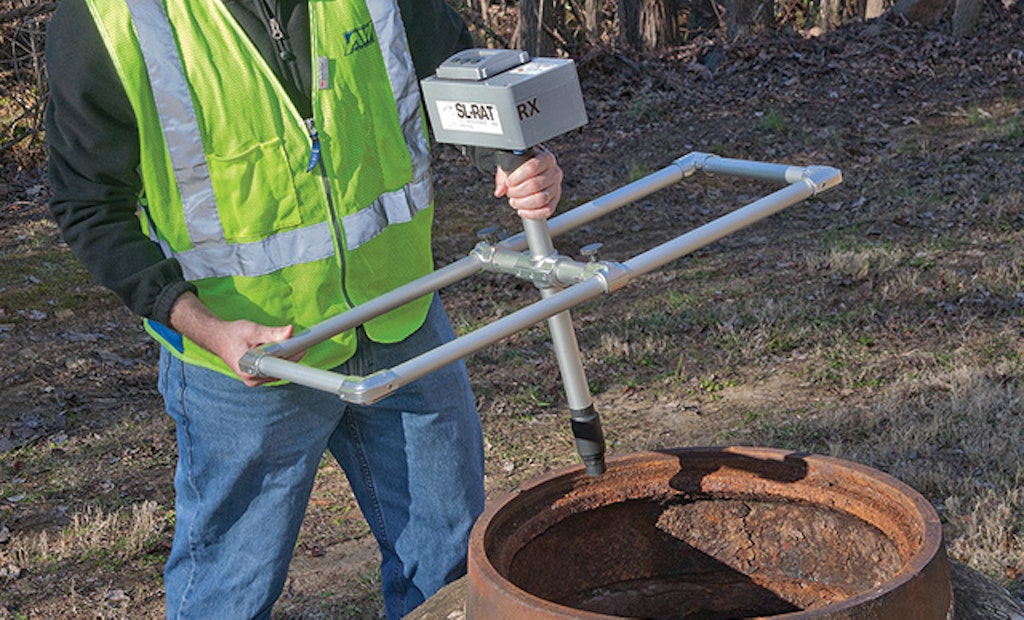Interested in Inspection?
Get Inspection articles, news and videos right in your inbox! Sign up now.
Inspection + Get AlertsThe sewer line rapid assessment tool (SL-RAT) from InfoSense provides an acoustic assessment of pipeline blockage in gravity-fed collection systems in less than three minutes and for less cost than closed-circuit TV (CCTV). Based on the concept of yelling and listening between manholes, the transmitter and receiver weigh less than 30 pounds together and are powered by a rechargeable battery (a typical 2- to 3-hour charge lasts for several days or approximately 80-100 inspections). The system is also GIS-integratable and GPS-enabled.
"This is a device that's portable, so when you're out there doing the measurements, you're getting the results live in the field," says George Selembo, chief executive officer for InfoSense. "There's a map-grade GPS in the unit, which is nice for analyzing data later, but usually we expect the operators to have a map with them of where they're supposed to be, and they write down immediately what the score is they got, telling them where the blockages are in the pipe segment." The lower the score, the greater the blockage: 0 is blocked and 10 is completely open.
"Based on our relationship with utilities, they want to know what they need to do," he continues. "It's not as important to get specific information about the blockage; it's important to know which segments require further attention — either jetting, rodding or video inspection." A high score also tells utilities which pipe segments don't require immediate attention, saving valuable camera time for segments in greater need of repair or cleaning. Scores appear on the receiver in real time and can be downloaded at the office. InfoSense's customers are seeing that 40 to 60 percent of the pipes they would have cleaned in the past do not need it once they use the SL-RAT.
"Basically, it rapidly helps you figure out how to prioritize your cleaning and inspection," Selembo says. "It's very safe, very easy to use and there's no contact with flow."
Typically used for 6- to 12-inch-diameter pipe, the assessment tool can be used in pipe up to 30 inches in diameter. Readings are not appreciably affected by pipe material, manhole depth or the number of twists and turns a segment might take.
The tool does require an estimate of the pipe length – plus or minus 100 feet. "It isn't something you need to know dead accurately," Selembo says. "You can rerun the score later if you found the pipe length was incorrect. And the GPS feature will typically calculate the pipe length for you between the two components."
The test, which can be done for one-tenth the cost of a CCTV inspection, is not intended to replace cleaning or camera inspection, but provides a means to focus and maximize the use of cleaning and camera equipment. Selembo says it helps prioritize where to put a camera — a very expensive piece of equipment — down a pipe. "You'd rather save that camera for when you need it. You don't want to clean pipes that are already clean," he says.
To assess a pipe segment for blockage, an operator places the transmitter atop a manhole and a second operator places the receiver atop an adjacent manhole. The manhole cover only needs to be moved enough to allow the speaker and microphone down approximately a foot into the hole. With the tool in place, the user with the transmitter radios the user with the receiver notifying him that a test is beginning, then pushes a button on the transmitter. When the test is complete, a blockage assessment number will register on the receiver and the crew can move on to the next segment of pipe.
"To give you an example, I was working with Two Rivers Utilities in the Charlotte (N.C.) area and we inspected 12,000 feet of pipe in four hours and 50 minutes. The average test was about 80 seconds," says Alex Churchill, COO of InfoSense. "Putting the transmitter and the receiver in the manhole is about 70 percent of the effort. The inspection itself is actually quite trivial." 877/747-3245; www.infosenseinc.com.






